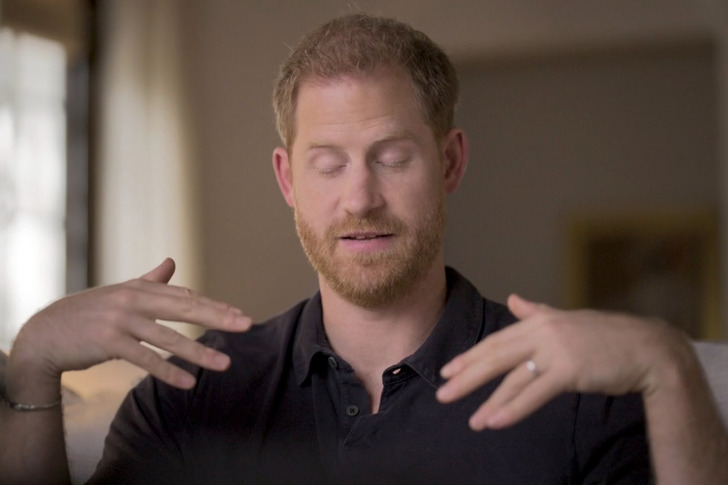Prince Harry recently opened up about his journey with post-traumatic stress disorder following the loss of his mother, Princess Diana. In a candid discussion, he revealed his exploration of a groundbreaking therapy that helped him.

The therapy is called eye movement desensitization and reprocessing (EMDR) to address the debilitating effects of his anxiety attacks. This revelation offers a glimpse into the royal’s personal struggles and his proactive approach towards mental health care, shedding light on the significance of seeking innovative treatments of traumas.
In a video, Prince Harry can be seen undergoing EMDR therapy, where he taps his shoulders and moves his eyes rapidly. This therapy is relatively new and is used to treat PTSD. Prince Harry shared that he decided to try EMDR to deal with severe anxiety attacks he was experiencing.
Prince Harry mentioned that he was open to trying EMDR because of the therapy and work he had done over the years.

During a therapy session with UK-based psychotherapist Sanja Oakley, Prince Harry demonstrated how EMDR helped him feel better about returning home. He described feeling scared and helpless before, but the therapy helped him cope with those feelings.
Prince Harry’s openness about his experience with EMDR therapy sheds light on alternative treatments for post-traumatic disorder and mental health struggles. It shows that seeking help and trying different therapies can make a difference in managing mental health conditions.

EMDR is a therapy made in 1987 to help with emotional traumas. It’s a structured therapy where you think about a tough memory while moving your eyes back and forth. This helps lessen the strong feelings tied to the memory.
EMDR works on a theory called Adaptive Information Processing (AIP). It says that trauma sticks around because it hasn’t been dealt with properly. So, when something reminds you of the trauma, those memories can come back strongly.
Unlike other therapies that try to lessen your reaction to trauma, EMDR tries to change how your brain stores those tough memories. Sometimes, instead of eye movements, you might listen to alternating tones. Usually, EMDR happens once or twice a week for about six to 12 sessions. But it can vary depending on the person.
Benefits of EMDR therapy
- EMDR is a structured therapy and usually needs fewer sessions than ongoing therapies.
- You don’t have to keep going back to the tough memory for a long time.
- You don’t have to talk a lot about what happened to you.
- There’s no homework to do.
- EMDR doesn’t try to change your thoughts and beliefs.
Disadvantages of EMDR therapy
- While EMDR is known to help with PTSD, it hasn’t been studied as much for other mood or mental health problems.
- If you’re avoiding talking about a tough event, EMDR might not be the best choice. Other types of talk therapy might work better.
- EMDR can sometimes make you feel worse at the start of treatment. The person who created EMDR warns that this could be dangerous for people who have gone through really tough things.
The process of EMDR
EMDR is a structured process with eight phases, each aimed at helping you deal with traumatic memories:
- History taking: Discuss your past with the therapist to identify which memories to focus on.
- Preparation: Learn about EMDR and how the therapist will use bilateral stimulation.
- Assessment: Identify your negative and positive beliefs related to the trauma.
- Desensitization: Use bilateral stimulation while recalling the memory.
- Installation: Focus on positive beliefs while processing the memory.
- Body scan: Talk about how you feel emotionally and physically.
- Closure: Prepare for what may happen between sessions.
- Reevaluation: Assess your progress and decide if more sessions are needed.
As you go through EMDR, you may start feeling less overwhelmed by the trauma. It’s normal for other painful memories to surface, indicating that suppressed memories are being processed.
When grappling with deep emotional traumas, it’s crucial to seek out specialists who can provide the appropriate form of treatment tailored to your needs. Whether it’s EMDR therapy or other therapeutic approaches, finding the right professional can make a significant difference in your healing journey.
Preview photo credit Good Morning America / YouTube
I Overheard My Daughter Saying ‘My Mom Has No Life Anyway, She’ll Have No Choice But to Babysit on Valentine’s Day’

As a single mom, I gave up my time, dreams, and everything for my daughter. But my heart broke when I overheard her laughing: “My mom has no life anyway. She’ll have no choice but to babysit on Valentine’s Day.” That’s when I decided — if she thought I had no life, I was about to show her otherwise.
Do I not deserve to have a life because I’m 45, a single mom, and a grandmother?
I never thought I’d be one this young. I had Miranda when I was 26. I worked hard and raised her right. But when she got pregnant at 18 and her boyfriend vanished into thin air, I stepped up. What else was I supposed to do? Let my daughter sink?

A distressed senior woman | Source: Midjourney
I still remember the night she told me she was pregnant. I held her as she sobbed into my shoulder. “I’m so scared, Mom,” she whispered. “I don’t know what to do.”
“We’ll figure it out together,” I promised, stroking her hair. “You’re not alone.”
And I meant every word.
I worked late shifts so she could attend college. Gave up my weekends so she could still feel like a normal teenager, going out with her friends. I told myself, “She’s young. She deserves a little freedom. I’ll help until she gets on her feet.”

A senior woman with a baby | Source: Midjourney
But then I overheard something that shattered me… something that made me realize my daughter had mistaken my love for obligation. The words that broke me… God, I hope no mother ever hears them.
It was the Monday before Valentine’s Day. I had just gotten home from work, exhausted, my feet throbbing and my back screaming. I was about to head to my room when I heard Miranda’s voice drifting down the hall.
I wasn’t eavesdropping until I heard my own name.
“Oh, don’t worry,” she giggled into the phone. “My mom has no life anyway. She’ll have no choice but to babysit on Valentine’s Day.”
I stopped dead in my tracks.

A young woman laughing while talking on the phone | Source: Midjourney
She kept going.
“She told me some dumb story about having a date with her coworker, but come on… her priority is MY DAUGHTER. She won’t actually go. I’ll just make her cancel, like always.”
Then she LAUGHED. Like my canceled plans, my sacrifices, and my entire damn existence was just some JOKE to her.
I pressed my hand against the wall to steady myself, memories flooding back. The promotion I turned down because it would mean less flexibility for babysitting. The countless nights I’d spent rocking Kelly to sleep while Miranda was out “studying.” The dating profiles I’d deleted because I never had time to actually meet anyone.
Something inside me snapped. She needed to learn that being a mother didn’t mean she got a free pass to dump her responsibilities on me. If she thought I’d just keep picking up the slack forever, she had another thing coming.

A shocked woman | Source: Midjourney
That night, she waltzed into my room, all sugar and innocence.
“Mom, I know you had that date, but I have this really special night planned for Valentine’s Day with my boyfriend, Matt. You’ll babysit, right?”
She batted her lashes. Smiled. Like I was some unpaid employee she could charm into another shift.
My hands trembled as I folded laundry, thinking of David from accounting. He’d been so genuine when he asked me out, his eyes crinkling at the corners. “Everyone deserves a second chance at happiness,” he said.
I smiled right back at Miranda. “Of course, sweetheart. Anything for you.”
She beamed. Hugged me. Told me I was “the best.”
She had no idea what was coming.

A young woman smiling | Source: Midjourney
Valentine’s Day arrived, and Miranda practically skipped out the door. She was glowing, her little red dress hugging her figure, and her hair straightened to perfection. She barely glanced at me as she grabbed her purse.
“Kelly’s already asleep,” she said breezily. “Should be an easy night. Love you, Mom!”
She didn’t wait for a response. Didn’t check if I was okay. Because in her mind I was exactly where she expected me to be — home, in my pajamas, and babysitting her child like always.
I looked at myself in the mirror, touching the slight wrinkles around my eyes. When had I started looking so tired? And resigned? The woman staring back at me wasn’t just a grandmother or a mother… she was someone who deserved more.

A heartbroken woman holding a mirror | Source: Midjourney
Thirty minutes later, I walked into the dimly lit restaurant with Kelly on my hip.
Miranda had been gushing about this fancy new restaurant all week, dropping the name like it was some exclusive VIP event. She never imagined I’d actually show up.
The hostess barely had time to greet me before I spotted them — Miranda, all dolled up, and across from her, some twenty-something guy with styled hair and a crisp button-down.
I marched straight up to their table. Miranda’s eyes widened.
“Mom?! What are you —”
I set Kelly in her lap.

A startled woman in a restaurant | Source: Midjourney
“At first, I was going to babysit,” I said sweetly. “But then I thought… what better way to test your relationship than to see how Matt handles real life? After all, if he’s serious about dating a single mom, he should be okay spending the night with both of you.”
Miranda’s face turned beet red.
Matt blinked. “Uh… what?”
I turned to him with a sympathetic smile.
“Oh, she didn’t tell you she has a baby? That’s odd. Considering she told me she’d make me cancel my plans for her hot date.”
Dead silence.
Kelly let out a tiny coo, oblivious to the chaos she had just been dropped into.

A stunned young man in a restaurant | Source: Midjourney
I patted Miranda’s shoulder. “Enjoy your night, sweetheart. Don’t wait up.”
And with that, I walked out, my heart pounding but my head held high.
When I got home, I barely had time to kick off my shoes before the front door slammed.
“MOM!” Miranda’s voice was shrill. “HOW COULD YOU DO THAT? YOU RUINED EVERYTHING!”
I turned slowly, crossing my arms. “You mean YOU ruined everything.”
Her mouth snapped shut.
“You heard me,” she whispered.
“Oh, I heard EVERY WORD you uttered, Miranda.”

An angry senior woman pointing her finger at someone | Source: Midjourney
She looked away, her cheeks burning. “Mom, I didn’t mean it like that —”
I let out a sharp laugh. “Oh, you meant exactly what you said. And tonight, you got to experience what happens when you assume I’ll ALWAYS be there.”
Her lips pressed into a thin line.”You don’t understand —”
“No, YOU don’t understand. Do you know how many nights I’ve sat alone in this house, wondering where my life went? How many times I’ve cried myself to sleep because I feel invisible? I have a life, Miranda. I deserve happiness too. And you? You don’t get to treat me like a built-in babysitter just because you had a baby young.”

A guilty woman with her eyes downcast | Source: Midjourney
Tears welled in her eyes, but she stayed quiet.
“Go to bed,” I muttered. “You need to start thinking about how you’ll do better.”
She swallowed hard. “Mom, I —”
“Not tonight, Miranda.”
And for the first time in years, I put myself first. The next morning, I sat at the kitchen table, sipping my coffee. Miranda shuffled in, her eyes puffy. She didn’t speak as she poured herself a cup.

A woman drinking a cup of coffee | Source: Midjourney
I let the silence stretch before I finally said, “There are going to be some changes.”
She stilled.
“Your daughter is YOUR responsibility. I will help… but I will not be manipulated into canceling my life for you.”
She nodded slowly.
“I am NOT your automatic babysitter. If you need me, you ASK… not assume.”
Her throat bobbed as she swallowed.
“And if you ever talk about me like that again,” I said, voice low, “you’ll be on your own.”
Tears slipped down her cheeks. “I get it.”
“I really hope you do.”

Portrait of a sad woman | Source: Midjourney
She sniffled. “I… I’m sorry, Mom. I never meant to make you feel… invisible.” She wiped her eyes. “When Dad left us, you were so strong. You never broke. You were always there. I guess… I started taking that strength for granted.”
I softened. “I know. But sorry isn’t enough. You need to show me.”
She gave a small nod. And for the first time, I saw it. The realization. The shift. She finally understood.
For years, I let myself be used because I thought that’s what a GOOD mother did. But you know what? A good mother teaches her child that respect goes both ways.And a great mother knows when to let her child learn the hard way.
You don’t mess with your mother just because she’s your mother. A mother isn’t just an endless well of sacrifices. She’s a person too. And I’ll be damned if I ever let my daughter forget it again.

A stern-looking woman with her arms crossed | Source: Midjourney
A week later, I watched from my kitchen window as Miranda struggled to load Kelly’s stroller into her car. In the past, I would have rushed out immediately, taken the baby, and solved everything.
Instead, I stirred my coffee and stayed where I was.
“Mom?” Her voice drifted through the open window, a hint of desperation creeping in. “Could you…maybe…”
I waited.
She took a deep breath. “Would you please help me? I have a job interview, and Kelly’s being impossible, and I know it’s last minute, but —”
I considered her request carefully, thinking about my own plans for the day. The boundaries I’d set weren’t just for show, they were for both of us.

A baby in a stroller | Source: Pexels
“What time is your interview?” I asked.
“Eleven. It would only be for two hours, maximum.”
“I can watch her from eleven to one,” I said finally. “But I have plans at two, so you’ll need to be back.”
The relief on her face was instant. “Thank you,” she said softly. “I mean it.”
Later that afternoon, I was getting ready for my date with David when Miranda came home. She lingered in my doorway, watching me apply lipstick.
“How did the interview go?” I asked, meeting her eyes in the mirror.
“I think… I think I got it.” She ran a hand through her hair, the exhaustion evident. “It’s at that accounting firm downtown. The one with the onsite daycare.”

An overwhelmed woman | Source: Midjourney
I nodded, carefully blotting my lips. “Smart thinking.”
“I’ve been looking into backup daycare options too,” she added quickly, like she was trying to prove something. “And I made a schedule for Kelly’s routine. So… so you don’t have to always be the backup plan.”
The old me would have jumped in with offers to help and reassurances that I’d always be there. Instead, I simply said, “That’s good planning, Miranda.”
She shifted uncomfortably in the silence that followed. “You look nice,” she finally said. “Are you seeing David again?”
“Yes.”
“Is it… is it serious?”
I turned to face her. “Would it matter if it was?”

An annoyed woman staring at someone | Source: Midjourney
She flinched slightly, and I saw the struggle in her eyes and the desire to fall back into old patterns and to make me feel guilty for having a life outside of her and Kelly.
“I —” she started, then stopped. Swallowed. Started again. “I’m trying to be happy for you, Mom. I really am. It’s just…”
“Just what?”
“It’s scary. Knowing I can’t always count on you being here.”
“You can count on me being your mother,” I said firmly. “But not on me giving up my life. There’s a difference.”
She nodded slowly, tears gathering in her eyes.

An upset young woman | Source: Midjourney
The restaurant was busy when I arrived, but David had already gotten us a table. As I sat down across from him, I noticed a couple at the next table over — a young mother with a baby, trying desperately to have a conversation with her date while juggling a fussy infant.
The scene was painfully familiar.
“Everything okay?” David asked, noticing my distraction.
I smiled, turning back to him. “Just thinking about how life changes. How we change.”
“Good changes?”
I thought about Miranda, about how she was finally facing the reality of being a young single mother instead of pushing everything onto me. And about how sometimes she still slipped into expecting me to drop everything for her, and how I was learning to stay firm even when it hurt.

A senior man in a restaurant | Source: Midjourney
“Necessary changes,” I answered. “The kind that hurt at first but make you stronger.”
He reached across the table, taking my hand. “You know what I admire about you? Your courage to start over. To demand respect. Not everyone can do that.”
I squeezed his hand, thinking about all the women out there — mothers, grandmothers, and caregivers — who had lost themselves in the act of loving others.
“Sometimes,” I said softly, “the bravest thing we can do is remember who we are. Not just who we are to other people, but who we are to ourselves.”

A heartbroken but confident woman | Source: Midjourney
Life isn’t a fairy tale. Because here’s the truth about mothers and daughters: we’re always growing, always learning, and always finding new ways to love each other. Sometimes that love looks like holding on. Sometimes it looks like letting go.
And sometimes, it looks like standing in your own truth and saying: “I am more than what you need me to be. I am a woman with dreams, desires, and a life of my own.”
And that doesn’t make me less of a mother. It makes me more of myself.
And in the end, that’s the greatest gift I could give to my daughter — showing her that a woman’s worth isn’t measured by how much she sacrifices. It’s measured by how truly she lives.

A woman smiling | Source: Midjourney
This work is inspired by real events and people, but it has been fictionalized for creative purposes. Names, characters, and details have been changed to protect privacy and enhance the narrative. Any resemblance to actual persons, living or dead, or actual events is purely coincidental and not intended by the author.
The author and publisher make no claims to the accuracy of events or the portrayal of characters and are not liable for any misinterpretation. This story is provided “as is,” and any opinions expressed are those of the characters and do not reflect the views of the author or publisher.



Leave a Reply